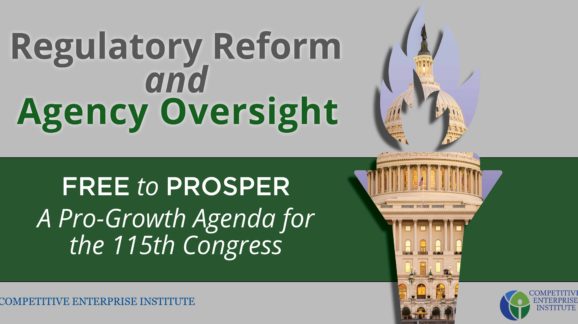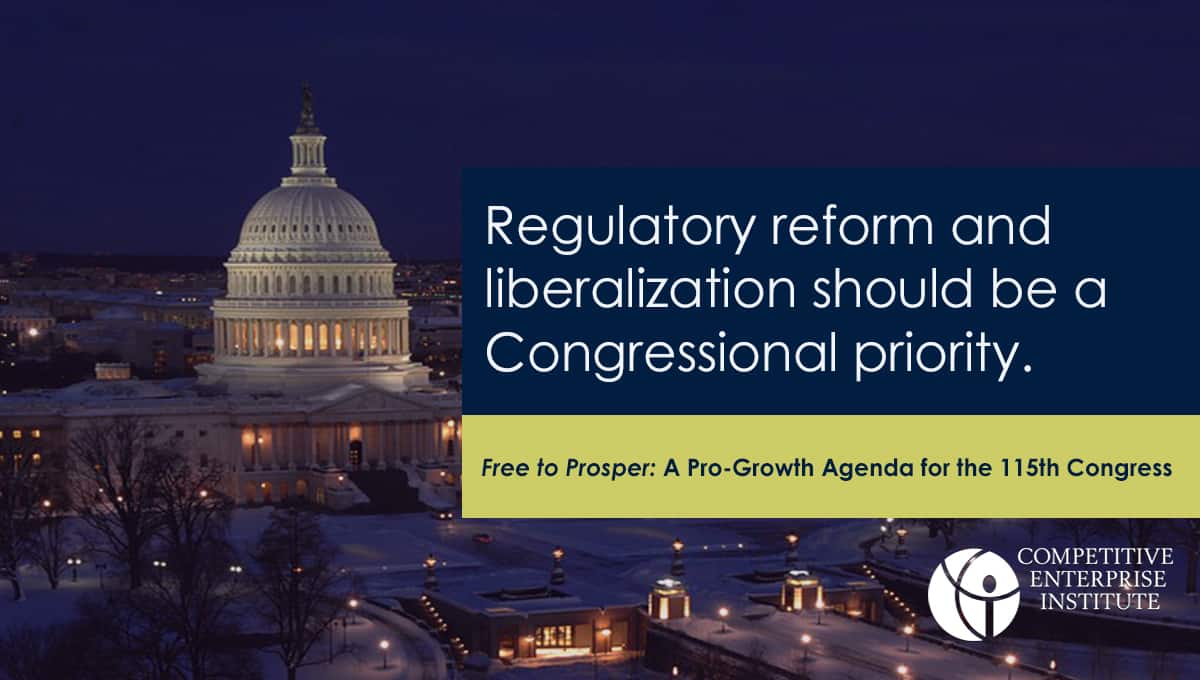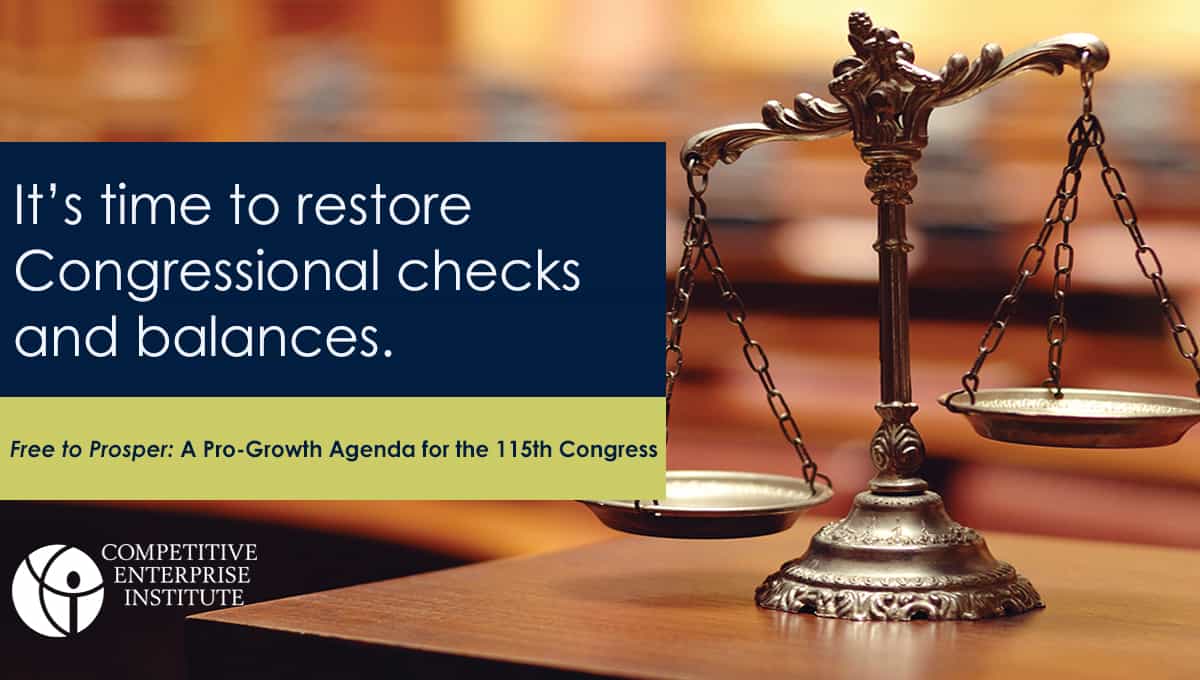Free to Prosper: Regulatory Reform
A Pro-Growth Agenda for the 115th Congress

View the full chapter on regulatory reform here
All legislative Powers herein granted shall be vested in a Congress of the United
States.
—Article 1, Section 1, U.S. Constitution
The United States of America has debated “Energy in the Executive” since the Federalist Papers championed the new Constitution’s ratification. But along with a doubling of the national debt in less than a decade, recent years have brought executive branch power and regulation to the forefront as the regulatory enterprise has attained new heights. Pages in the Federal Register, the daily repository of all proposed and final federal rules and regulations, occupy historic levels, having finished 2015 at 80,260 pages (Figure 1.1).
Although regulators overreach, Congress has stood by without using existing tools at its disposal to rein in the ever-growing regulatory state—including oversight hearings, insistence on agency adherence to the Administrative Procedure Act (APA), defunding and appropriations process options, and the resolution of disapproval process established by the Congressional Review Act (CRA). As 2016 House of Representative task forces on Article I powers and economic liberalization contended, Congress should reassert its constitutional oversight responsibilities and implement a series of regulatory reforms and liberalizations. Those include, broadly, limiting regulatory agency authority, reforming the rulemaking process, employing the power of the purse to regulate agencies, and increasing oversight.
What is the effect of regulatory excess? Unemployment is “down” because statistics omit those who have given up the job hunt, as labor force participation is at historic lows. Instead, we see reduced business ownership, lower self-employment rates among the young, declining rates of small business formation, and more businesses closing than are being created.

To put the upcoming recommendations into context, we should note specific shortcomings in oversight of the ordinary, everyday rules and regulations.
First, the central review process conducted by the White House Office of Management and Budget (OMB)—to presumably ensure that rules’ benefits exceed costs—is lacking. That executive branch regulatory review was initially formalized by President Ronald Reagan’s Executive Order 12291 (February 17, 1981) and extended in less strict form by subsequent executive orders from other presidents. As Table 1.1 shows, of over 3,500 rules issued by agencies annually, cost–benefit analyses reviewed by the OMB exist for only about a dozen, with a handful of other rules accompanied by a reviewed cost analysis.
Second, the Administrative Procedure Act’s notice-and-comment rulemaking process is broken. Agencies routinely fail to issue notices of proposed rulemaking for a substantial portion of their rules, thereby undermining democratic accountability and the public’s opportunity to weigh in on rules affecting them, according to a December 2012 Government Accountability Office (GAO) report.
Third, Congress rarely defunds agency actions that overstep an agency’s statutory authority.
Fourth, Congress rarely uses its most powerful accountability tool, the Congressional Review Act, to pass resolutions of disapproval of costly or controversial agency rules. To improve regulatory cost accountability, in 1996 Congress passed the CRA, which sets up a 60-day period following agency publication of a regulation during which the rule will not take effect. That 60-day pause affords Congress an opportunity to pass a resolution of disapproval to halt the regulation. Congress has used it sparingly. And apart from the 2001 repeal of an intrusive Department of Labor ergonomics rule that would have put undue burdens on home offices, no CRA vote has resulted in repeal of a final rule.
Fifth, even if Congress were inclined to aggressively assert its legitimate authority over the regulatory enterprise, the CRA itself is further undermined by agency nonobservance of its procedures. As Curtis W. Copeland, a specialist in American government, demonstrated in a white paper prepared for the Administrative Conference of the United States, agencies no longer properly submit many final rules to the GAO’s comptroller general and to Congress as required by the CRA. That submission is viewed as necessary should Congress introduce a formal CRA resolution of disapproval of an agency rule, so its neglect creates a major lapse in accountability.

With spotty public notice and inadequate accountability, it is imperative that Congress frequently go on record regarding the merits of particular regulations. That process matters, because although overall rules have since settled around the 3,500 mark annually, the costly “economically significant” subset has risen, as Figure 1.2 shows.
Much overregulation stems from a breakdown of checks and balances under the Constitution’s separation of powers. Overdelegation by Congress has enabled regulatory agencies to pursue ambitious efforts to assert control over wide swaths of the American economy through both rules and guidance. On the one hand, executive branch and regulatory actions require far more congressional oversight, including hearings, better information disclosure, and slashing budgets of agencies when they exceed their bounds. On the other hand, Congress needs to grapple with the reality that lawmakers themselves are the source of overdelegation, and that Congress has relinquished much of its legitimate authority to the executive branch.
In a two-pronged approach, Congress must heighten disclosure of regulatory matters, and its own accountability for the “law” that regulatory agencies make, either formally as notice-and-comment regulation or informally as guidance and “dark matter.” Congress can start by recognizing the fundamental need to enforce the Administrative Procedure Act’s scrutiny of rules and incorporate “regulatory dark matter” into the process.
In this chapter:
- Improve Regulatory Oversight and Accountability
- Rein in Overregulation and Regulatory “Dark Matter”
- Strengthen Disclosure with a “Regulatory Report Card”
- Implement a Regulatory Reduction Commission and Sunset Procedures
- Require Votes on Major or Controversial Rules
- Implement a Regulatory Cost Budget
- Restrain the Runaway Administrative State by Reining in Chevron Deference